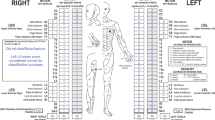Abstract
Sacral reflexes are important to allow the SCI practitioner to gain information about the state of the sacral spinal cord segments. The presence of the bulbocavernosus and/or the anal wink reflex indicate an intact spinal reflex arc and reflex conal autonomic function (as part of the upper motor neuron syndrome); their absence defines a lower motor neuron syndrome. The assessment of sacral reflexes helps predict the type of bladder, bowel and sexual functions and the related therapeutic interventions. We suggest adding the sacral component of the International Standards for the Assessment of Autonomic Function after SCI (ISAFSCI) to the International Standards for the Neurologic Classification of Spinal Cord Injury (ISNCSCI) examination so there can be a detailed description of these important functions. As an alternative, the performance of sacral reflexes should be routinely required as part of the neurologic examination after SCI. Whether the sacral motor neuron system is classified as upper or lower motor neuron injury is also quite useful and as such should be present in the ISCNSCI.
Similar content being viewed by others
Log in or create a free account to read this content
Gain free access to this article, as well as selected content from this journal and more on nature.com
or
References
Association. ASI. Standards for neurological classification of spinal cord injury patients. Chicago: American Spinal Injury Association; 1982.
Kirshblum SC, Burns SP, Biering-Sorensen F, Donovan W, Graves DE, Jha A, et al. International standards for neurological classification of spinal cord injury (revised 2011). J Spinal Cord Med. 2011;34:535–46.
Alexander MS, Biering-Sorensen F, Bodner D, Brackett NL, Cardenas D, Charlifue S, et al. International standards to document remaining autonomic function after spinal cord injury. Spinal Cord 2009;47:36–43.
Alexander M, Aslam H, Marino RJ. Pulse article: how do you do the international standards for neurological classification of SCI anorectal exam? Spinal Cord Ser Cases. 2017;3:17078.
Previnaire JG. The importance of the bulbocavernosus reflex. Spinal Cord Ser Cases. 2018;4:2.
Roberts MM. Neurophysiology in neurourology. Muscle Nerve 2008;38:815–36.
Uher EM, Swash M. Sacral reflexes: physiology and clinical application. Dis Colon Rectum. 1998;41:1165–77.
Maury. La paraplégie. Paris: Flammarion Médecine Sciences; 1981.
Doherty JG, Burns AS, O'Ferrall DM, Ditunno JF Jr. Prevalence of upper motor neuron vs lower motor neuron lesions in complete lower thoracic and lumbar spinal cord injuries. J Spinal Cord Med. 2002;25:289–92.
Previnaire JG, Soler JM, Alexander MS, Courtois F, Elliott S, McLain A. Prediction of sexual function following spinal cord injury: a case series. Spinal Cord Ser Cases. 2017;3:17096.
Alexander MS, Marson L. The neurologic control of arousal and orgasm with specific attention to spinal cord lesions: integrating preclinical and clinical sciences. Auton Neurosci. 2018;209:90–9.
Blaivas JG, Zayed AA, Labib KB. The bulbocavernosus reflex in urology: a prospective study of 299 patients. J Urol. 1981;126:197–9.
Ko HY. Revisit spinal shock: pattern of reflex evolution during spinal shock. Korean J Neurotrauma. 2018;14:47–54.
Alexander MS, Carr C, Chen Y, McLain A. The use of the neurologic exam to predict awareness and control of lower urinary tract function post SCI. Spinal Cord 2017;55:840–3.
Sipski ML, Alexander CJ, Rosen R. Sexual arousal and orgasm in women: effects of spinal cord injury. Ann Neurol. 2001;49:35–44.
Author information
Authors and Affiliations
Corresponding author
Ethics declarations
Conflict of interest
JGP has nothing to disclose. MA is author of the book “sexual sustainability”.
Additional information
Publisher’s note Springer Nature remains neutral with regard to jurisdictional claims in published maps and institutional affiliations.
Rights and permissions
About this article
Cite this article
Previnaire, J.G., Alexander, M. The sacral exam—what is needed to best care for our patients?. Spinal Cord Ser Cases 6, 3 (2020). https://doi.org/10.1038/s41394-019-0252-2
Received:
Accepted:
Published:
DOI: https://doi.org/10.1038/s41394-019-0252-2
This article is cited by
-
Pleasurable and problematic receptive anal intercourse and diseases of the colon, rectum and anus
Nature Reviews Gastroenterology & Hepatology (2024)
-
Sexual health and treatment-related sexual dysfunction in sexual and gender minorities with prostate cancer
Nature Reviews Urology (2023)
-
Use of the ice water test as an early predictor of recovery of erectile function in patients with spinal cord injury
Spinal Cord Series and Cases (2020)
-
Bulbocavernosus or anal reflex, one or both should be tested after spinal cord injury
Spinal Cord Series and Cases (2020)


